11th December - 17th December
Group C: Tiana Robison Randriaharimalala, Ziyou Yin, Binru Liu, Kate Chernysheva
Research Method: Literature Review & Prototyping
Group C: Tiana Robison Randriaharimalala, Ziyou Yin, Binru Liu, Kate Chernysheva
Research Method: Literature Review & Prototyping
BRIEF : Design an experience that reveals what happens when we read
Reading is an important medium for acquiring knowledge and is a crucial and complex brain process. This week we focused on creating an experience that gives a better understanding of what occurs in our minds when we read.
This week was a little different for me as I was away from London and couldn’t be there in person with my group. However, we stayed in touch online, divided the workload and worked very well as a team.
Screenshot taken during an online meeting, Taken by Kate.
RESEARCH & IDEATION
We started off our project by conducting some preliminary research individually and later on gathered all of our findings together in a google doc. This formed an essential basis for our Literature Review, a method suggested by the brief along with Prototyping.
Upon carefully studying our findings, we divided them into different categories and themes according to their content and began to brainstorm. To do that we thought of using the Crazy 8 method that would help us hear each other’s ideas, iterate and discuss them together.



Sketches made while brainstorming. Sketches made by Kate.
Crazy 8 made by Kate.
Immediately after using this method we had 4 different concepts that we wanted to pursue and created some sketches of them in order to present them to John Fass at the upcoming tutorial.
Ideas 1 was to create an experience of a treasure hunt. Idea illustrated by Tiana.


Idea 2 was based on our discovery that reading a descriptive text of a certain action triggers the related brain areas as if the person was performing the action him/her self (de Lafuente and Romo, 2004; Emory, 2012). Idea illustrated by Tiana.
Idea 3, similarly to Idea 2, revolved around the connection of mind and body. As a development from Idea 2 we wanted to involve more senses like touch and taste to translate this idea. Idea illustrated by Tiana.
Idea 4 was to do with the reading and our senses. We wanted to create 4 different space that would translate different moods. A person sitting in the space would read a passage that is contrasting to the mood around him/her. Idea illustrated by Kate.
We received very positive feedback on our work and Idea 1 stood out the most. It seemed to be adventurous and engaging which we wanted our experience to be. However, we were left with some details that we felt very unclear about which was the puzzle part. We knew there would be a process of assembling a puzzle that would later lead to finding the treasure.
It took us quite some time to create a clear vision. We went through lots of different ideas and types of riddles such as rebus, crosswords, word search as they all could be metaphorically compared to the learning stages of reading we explored through the article by J. Caffrey (2019). Nothing seemed to fit enough until I remembered my favourite - the Einstein Puzzle, which inspired our experience and made the game to be focused in deductive reasoning.
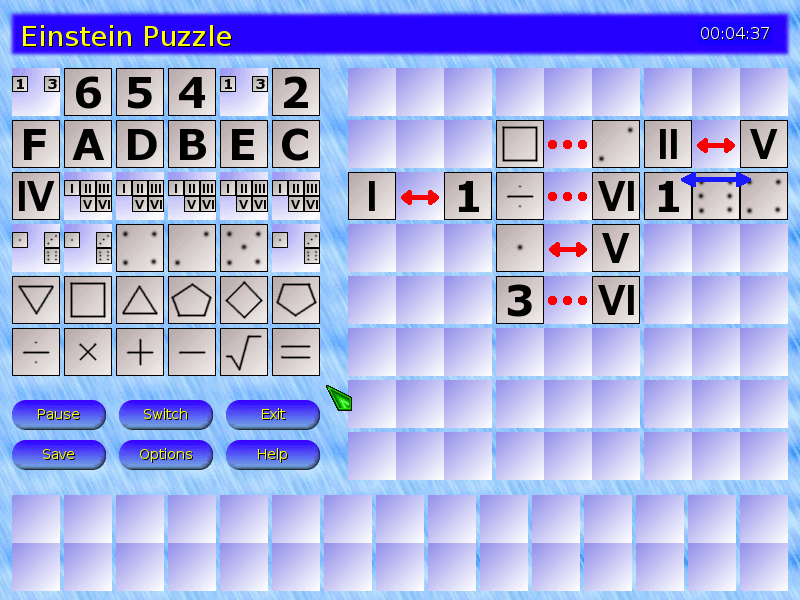

Examples of the Einstein puzzle. Images taken from online sources included in the bibliography section.
PROCESS
Unfortunately, I wasn’t there to physically help my team to prepare, and be part of the Prototyping stage. Hence, I took the responsibility of organising our Literature Review findings. I created themed mind maps that had the most crucial facts of our research to give a clear and visual overview to everyone at the presentation.
A mind map of findings on the topic of reading, sound and environment. Mind map created by Kate.
A mind map of findings on the topic of reading and senses. Mind map created by Kate.
A mind map of findings on the topic of reading, mental image and visual imagery. Mind map created by Kate.
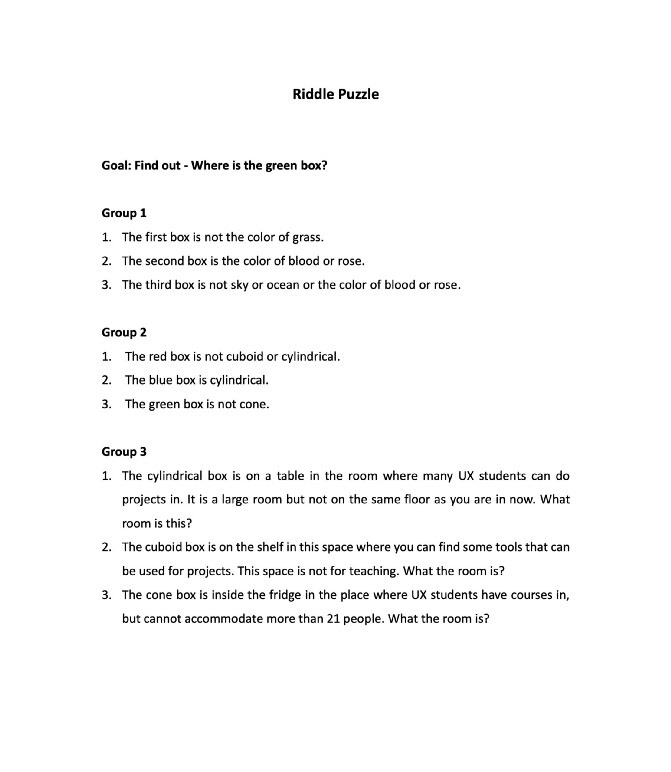


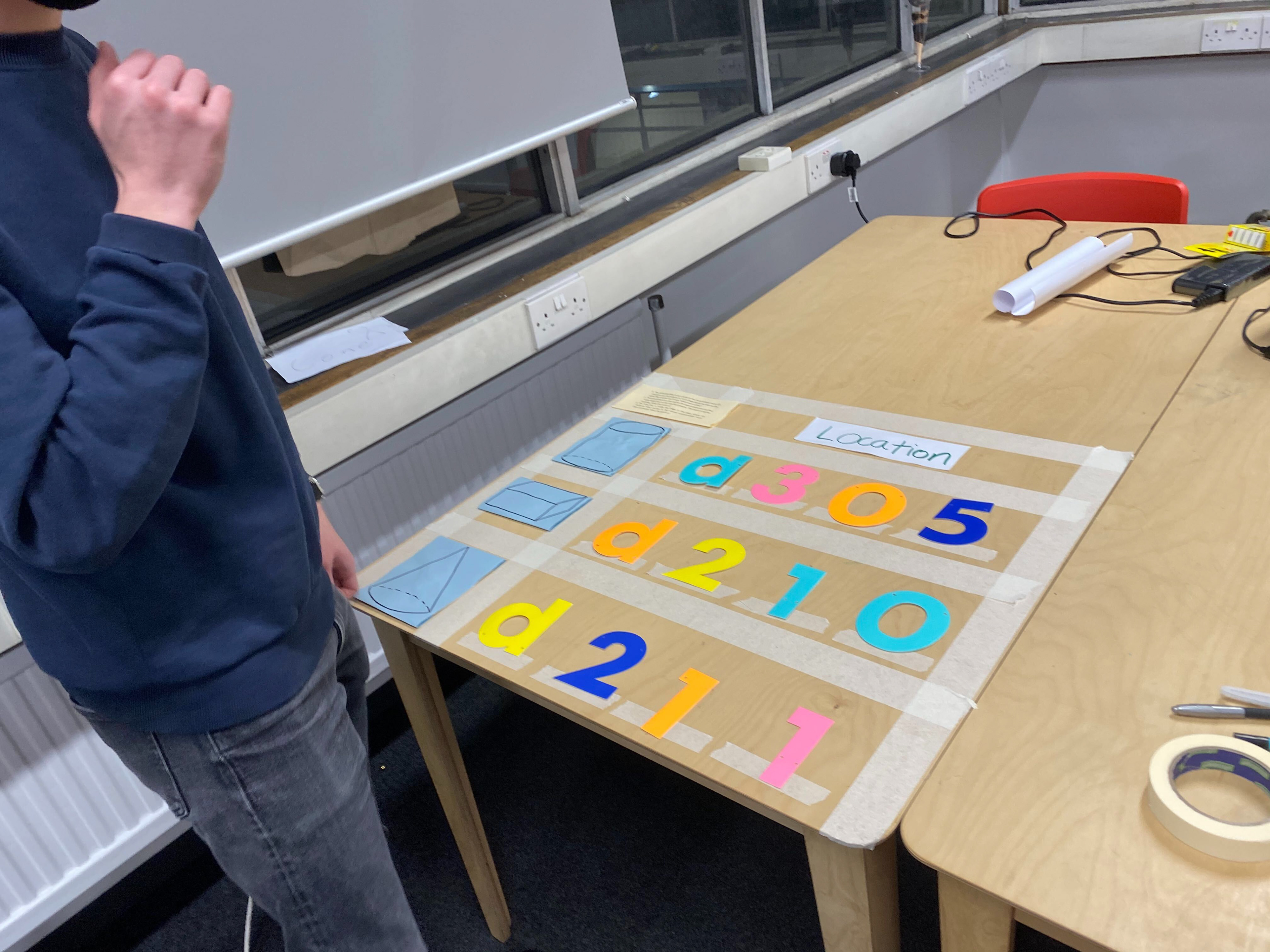
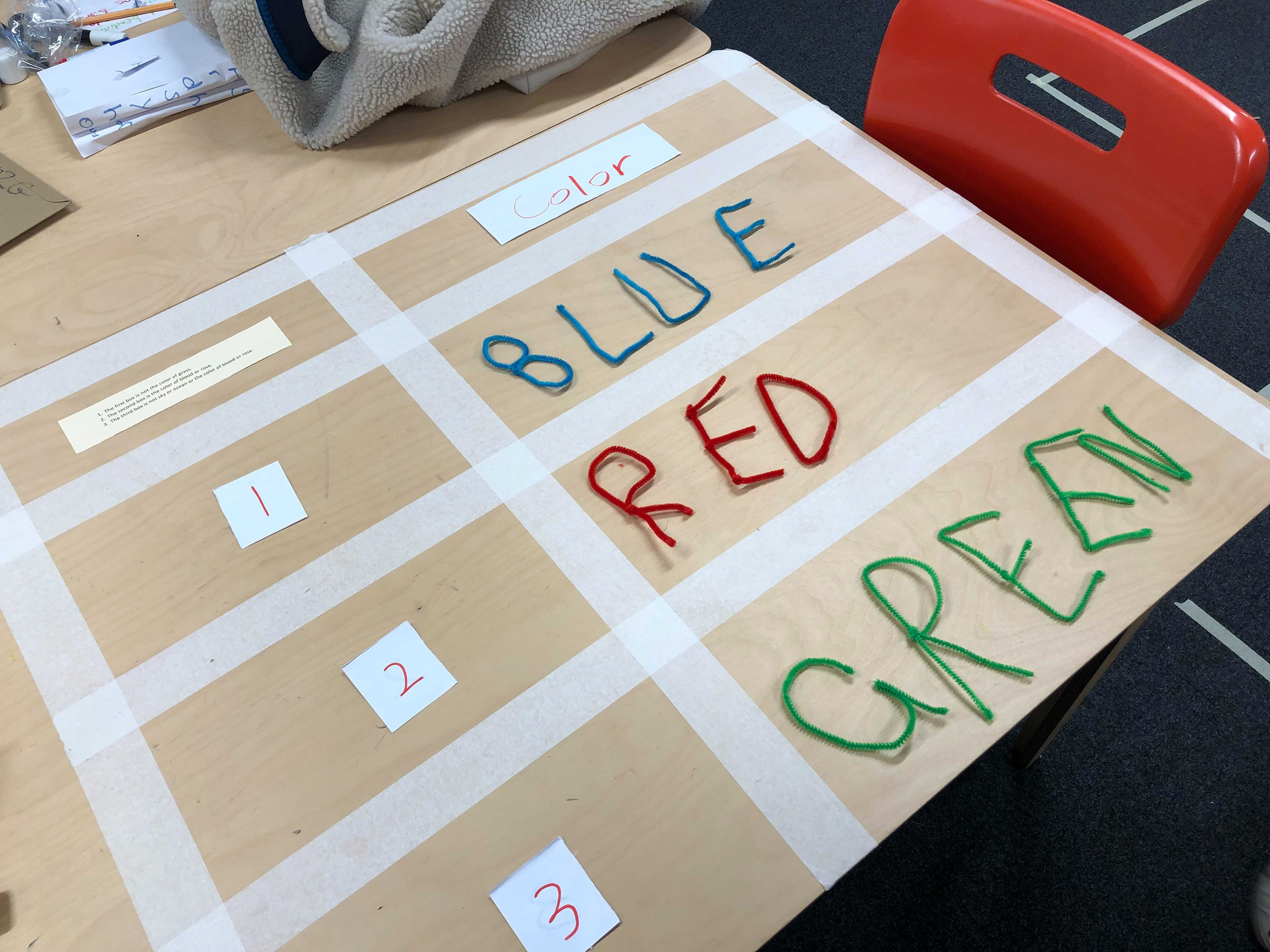
Some images from the preparation day. Taken by Binru and Tiana.
In the end, the game went as follows. Class was divided into three different groups and each was given a riddle to solve. An answer to their individual riddles were the location, colour and the shape which were later combined in order to find the true treasure.
Presentation & Feedback

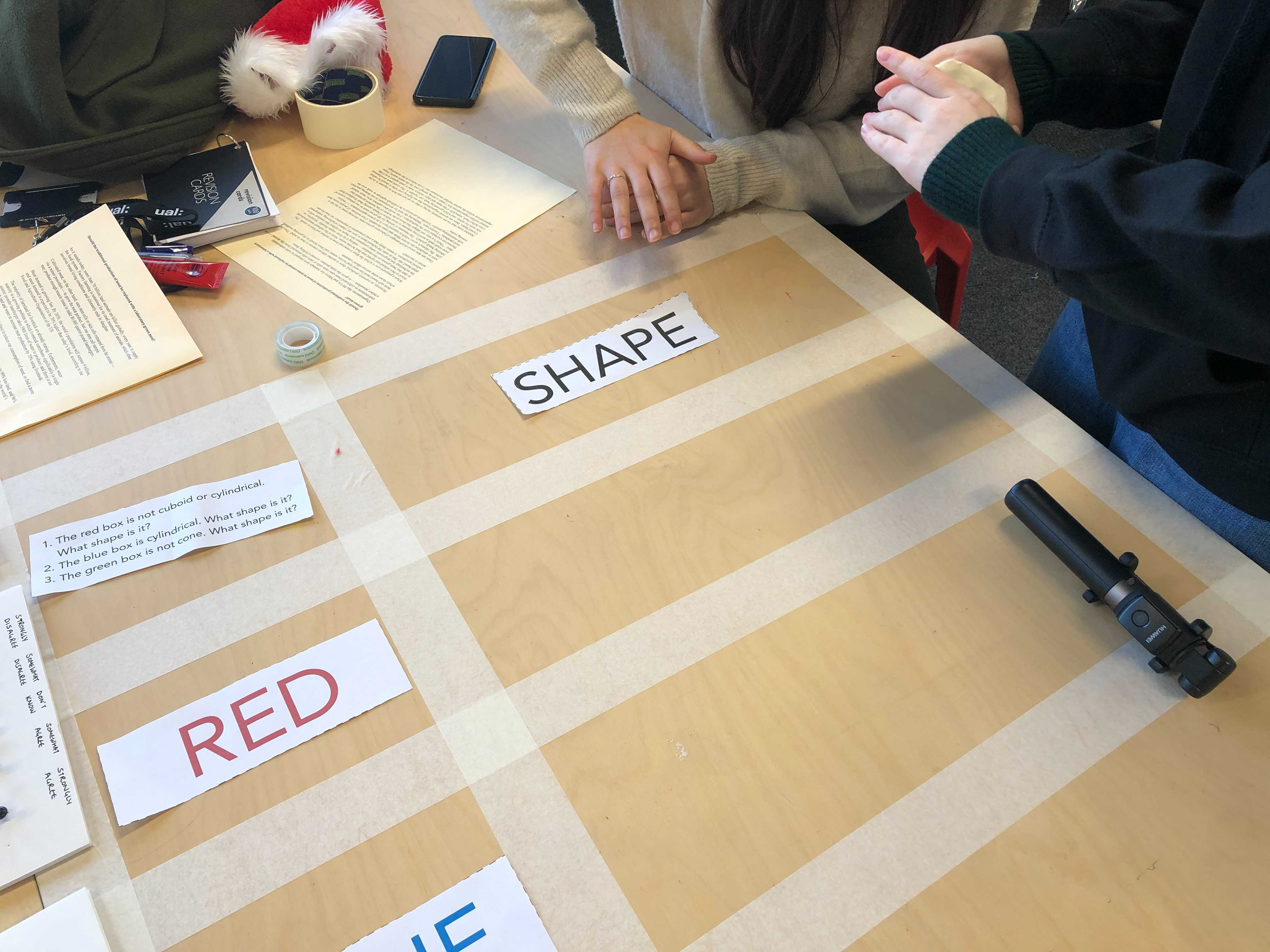


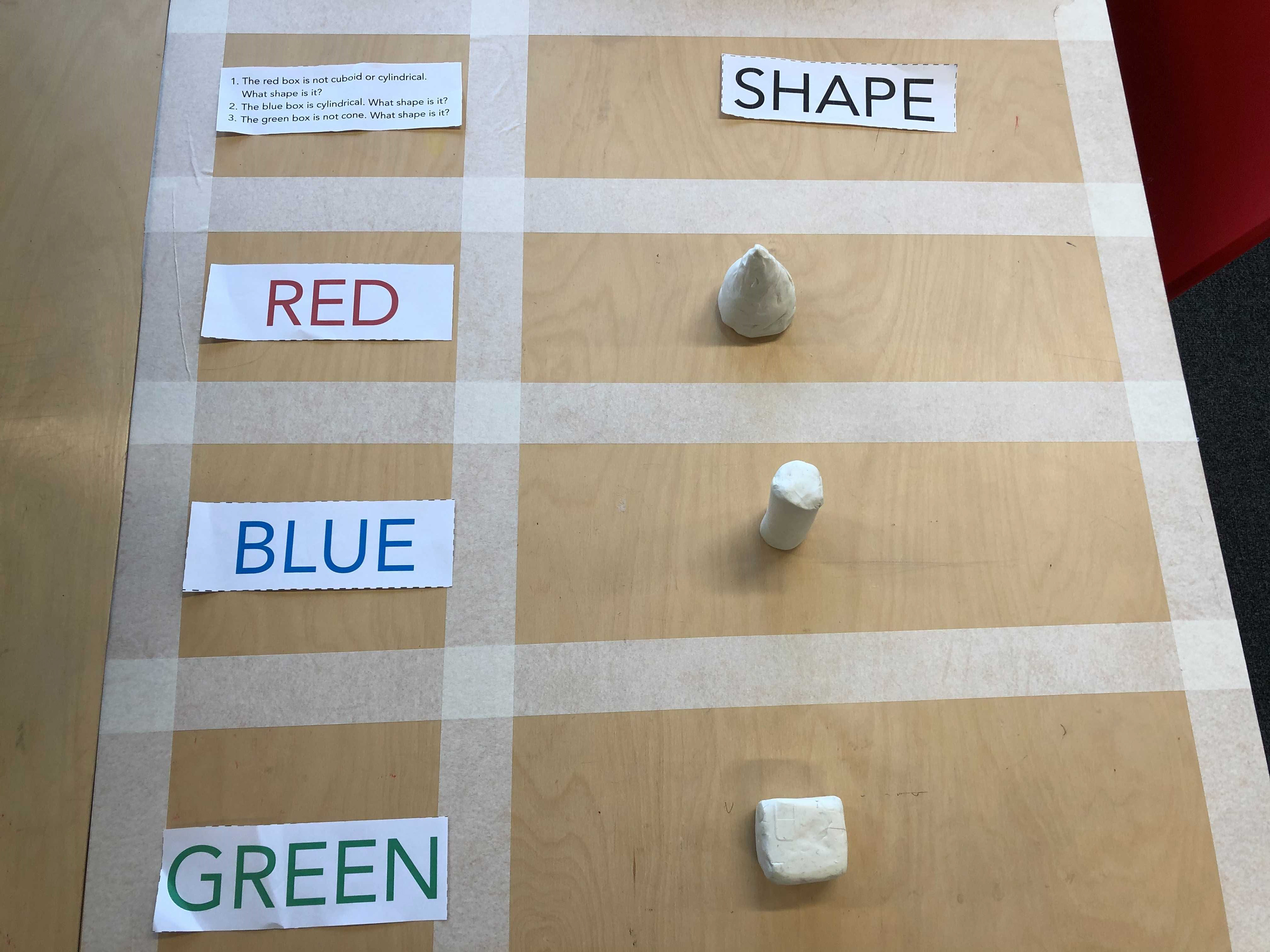


Images from the presentation day. Taken by Binru.
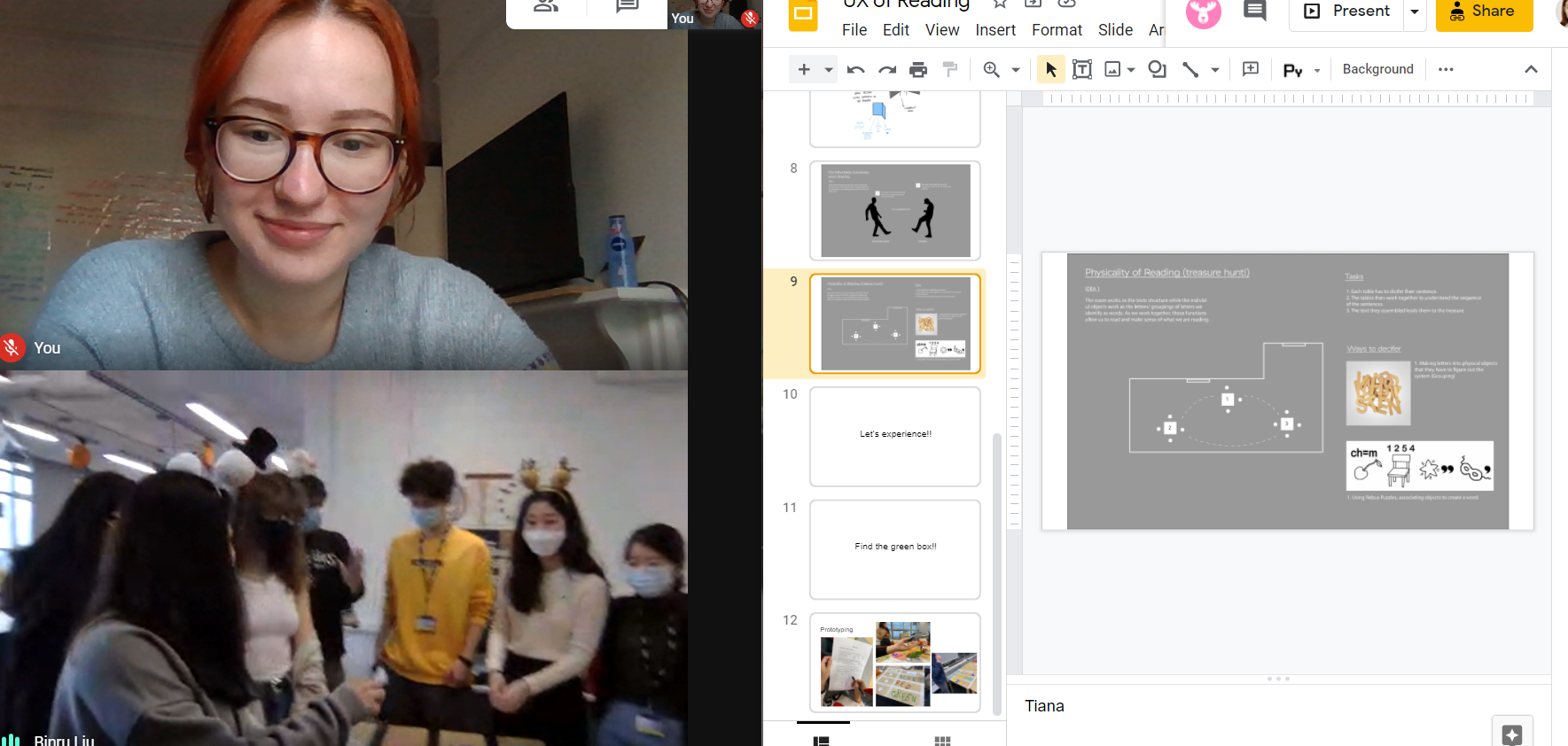

Screenshot from the presentation day. Taken by Kate.
Video from the presentation day. Taken by Ines.
I was very happy to be able to participate in the presentation online and talk through our literature review findings. Overall, we received very positive feedback from our peers as they felt engaged and interested in the activities. Some confirmed to experience visual imagery when reading descriptive sentences. However, there is always room for improvement which we could achieve through correcting some mistakes in our referencing, such as brackets for the publishing year and italics for the titles of the books and journals we used.
bibliography
Caffrey, J. (2019). The Developmental Stages Of Learning To Read - Lexplore. [online] Lexplore. Available at: <https://www.lexplore.com/en/the-developmental-stages-of-learning-to-read/> [Accessed 13 January 2021].
Caracciolo, M., and Hurlburt, R. T. (2016). A passion for specificity. Columbus: The Ohio State University Press.
Brouwers, V. P., Heavey, C. L., Lapping-Carr, L., Moynihan, S., Kelsey, J., & Hurlburt, R. T. (2018). Pristine inner experience: While silent reading it's not silent speaking of the text. Journal of Consciousness Studies, 25(3–4), 29–54.
de Lafuente, V. and Romo, R. (2004). Language Abilities of Motor Cortex. Neuron, [online] 41(2), pp.178-180. Available at: <https://www.sciencedirect.com/science/article/pii/S0896627304000042> [Accessed 21 December 2020].
Etaugh, C. and Michals, D. (1975). Effects on Reading Comprehension of Preferred Music and Frequency of Studying to Music. Perceptual and Motor Skills, 41(2), pp.553-554.
Fennema, E. (1959). Mental Imagery and the Reading Process. The Elementary School Journal, [online] 59(5), pp.286-289. Available at: <https://www.jstor.org/stable/999400> [Accessed 14 December 2020].
Jabr, F. (2013). The Reading Brain In The Digital Age: The Science Of Paper Versus Screens. 1st ed. [ebook] Available at: <https://blogs.ethz.ch/deliscope/files/2013/09/The-Reading-Brain-in-the-Digital-Age-The-Science-of-Paper-versus-Screens-Scientific-American.pdf> [Accessed 14 December 2020].
Johansson, R., Holmqvist, K., Mossberg, F. and Lindgren, M. (2011) Eye movements and reading comprehension while listening to preferred and non-preferred study music. Psychology of Music, 40(3), pp.339-356.
Kuzmicova, A. (2012). Fidelity without mimesis: Mental imagery from visual description. In Gregory Currie, Petr Kotatko & Martin Pokorny (eds.), Mimesis: Metaphysics, Cognition, Pragmatics. College Publications.
Lacey, S., Stilla, R. and Sathian, K. (2012) Metaphorically feeling: Comprehending textural metaphors activates somatosensory cortex. Brain and Language, [online] 120(3), pp.416-421. Available at: <https://www.sciencedirect.com/science/article/pii/S0093934X12000028?casa_token=tFZUVTJFbUMAAAAA:dTnugI8ii3oaQnoSl6JNd7SspCDRjXL2DMF213tzroY6Z2yvFY53nhOOdBmxWXIaHdEZE2Ux0X4> [Accessed 14 December 2020].
Ludlam, K. (2012). Hearing metaphors activates sensory brain regions. [online] Emory. Available at: <https://news.emory.edu/stories/2012/02/metaphor_brain_imaging/> [Accessed 21 December 2020].
Moore, A.T. and Schwitzgebel, E. (2018) 'The experience of reading', Consciousness and cognition, 62, pp. 57-68.
Nell, V. (1988). The Psychology of Reading for Pleasure: Needs and Gratifications. Reading Research Quarterly, 23(1), p.6.
Thompson, W., Schellenberg, E. and Letnic, A. (2011). Fast and loud background music disrupts reading comprehension. Psychology of Music, 40(6), pp.700-708.
Zhang, H., Miller, K., Cleveland, R. and Cortina, K. (2018). How listening to music affects reading: Evidence from eye tracking. Journal of Experimental Psychology: Learning, Memory, and Cognition, 44(11), pp.1778-1791.
IMAGES
Einstein Puzzle computer game (left picture):
https://community.linuxmint.com/img/screenshots/einstein.png
Einstein puzzle (right picture):
https://i2.wp.com/lyanacrosswordpuzzles.com/wp-content/uploads/2019/06/einsteins-riddle-detective-style-logic-activity-all-esl-printable-einstein-puzzles.png
Images used for mind maps in order of appearance in this blog:
https://previews.123rf.com/images/arjunaalvarendra/arjunaalvarendra2004/arjunaalvarendra200400006/144250764-young-man-reading-the-book-and-listening-music-with-headphone-stay-at-home-for-prevention-measures-f.jpg
https://encrypted-tbn0.gstatic.com/images?q=tbn:ANd9GcQ6PrUmMiIhYe8igpJ81l_n73t2yoE2jWX96g&usqp=CAU
https://ars.els-cdn.com/content/image/1-s2.0-S0896627304000042-gr1.jpg
https://www.sciencedirect.com/science/article/pii/S1053810017303859
https://olivehickmott.files.wordpress.com/2017/09/elephan.jpg?w=257